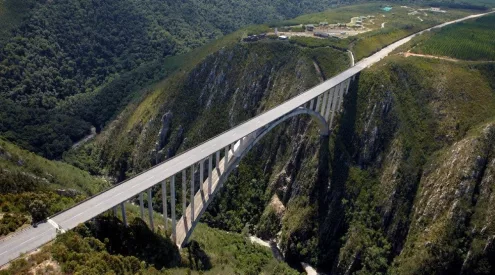Sylvester the lion rose to fame in 2015 for his escape artist antics. The male lion escaped from the Karoo National Park twice and took expert trackers on a wild goose chase for over 350km, where he was nicknamed ‘Spook’. On his adventure, Sylvester feasted on 28 sheep, a Nguni cow, and a kudu.
Following Sylvester’s second runaround, this time with a tracking collar, SANParks made the decision to relocate the unsettled lion to the Addo Elephant National Park.
Here he’d have an opportunity to grow and develop, away from the pressures of the other males at Karoo National Park. Sylvester was moved in May 2016, and it turned out to be a match made in heaven. The once-restless male quickly settled down with a female named Angel, with whom he sired two sons (Cambro and Gamke).
He shares the coalition with a younger male, Fielies, who fathered two cubs (Cat and Liam) with Angel’s sister, Nicka.

Now two years old, the four cubs have grown into healthy sub-adults and are showing signs of independence of their own.
Joining the prides at Magic Hills Private Game Reserve
According to best practices of lion management in South Africa, when young lions are of an age to disperse it becomes necessary to work with other reserves to swap young lions in order to maintain the genetic integrity of the various metapopulations (managed sub-populations).
With one existing pride of seven lions roaming the Magic Hills Private Game Reserve in Eastern Cape, the opportunity to move Sylvester’s sons, his niece and nephew to the Magic Hills area seems like yet another perfect match.
While Sylvester and Fielies are first-generation Kalahari origin lions (via Karoo National Park), the lions of Magic Hills are of the Etosha bloodline, which has been the predominant lion in South Africa for over 30 years.
The opportunity to combine the genetics of these prides would significantly reduce the risks of inbreeding, while also increasing the population on the reserve.
Speaking of the benefits of increasing lion population at Magic Hills, General Manager Declan Hofmeyr states, ‘They play an obvious role, removing the old and sick of prey species, but they also create a landscape of fear, so that herbivores are more likely to gather in herds than walk around as individuals. Herding reduces the spatial impact of trampling since prey species focus in smaller areas which results in an ‘accidental’ protection of vegetation. Lions are surprisingly good for the land, itself.’
The relocation process and desired outcome
The four young lions, Cambro, Gamke, Cat and Liam, were transported and released on the October 6, 2020. They will be kept in a 40 hectare boma for 4-6 weeks, where they will be monitored and have opportunity to acclimatise to their new surroundings.
All four of the lions will have received treatment against potential parasites on arrival, as well as a vitamin boost for the best chance at healthy adaption to the new environment.
Speaking of the social dynamics on the reserve, Hofmeyr anticipates that the new lions will likely avoid the territories of the existing Magic Hills pride for at least a year, steering clear of the dominant male.
It is Hofmeyr’s hope that, once the four young lions reach maturity, the new males will seek out the Magic HIlls females, and the new female, Cat, will seek out a Magic Hills male.
He says, ‘Our aspiration for these lions is that they, along with our existing pride, form a new and viable, managed population of wild lions.’
The Magic Hills Private Game Reserve is a 20 100-hectare reserve, dedicated to the regeneration of the landscape as well as the reintroduction of indigenous species. The transfer of Sylvester’s family cubs to the Magic Hills Private Game Reserve is but one step – a giant leap – toward restoring the area to its former natural glory.
Picture: Supplied


















